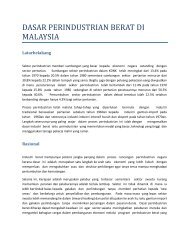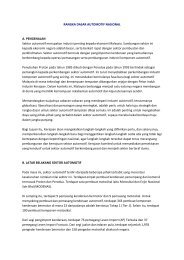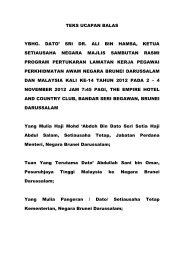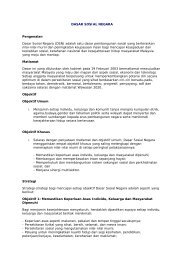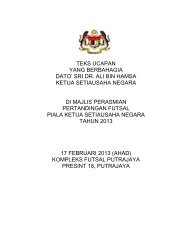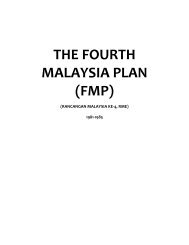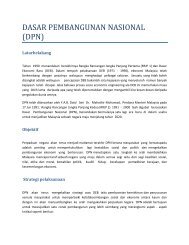Chapter 6 Reducing crime - Prime Minister's Office of Malaysia
Chapter 6 Reducing crime - Prime Minister's Office of Malaysia
Chapter 6 Reducing crime - Prime Minister's Office of Malaysia
You also want an ePaper? Increase the reach of your titles
YUMPU automatically turns print PDFs into web optimized ePapers that Google loves.
GTP Roadmap<strong>Chapter</strong> 6: <strong>Reducing</strong> CrimeFigure 6.2How reducing <strong>crime</strong> contributes to 1<strong>Malaysia</strong>High <strong>crime</strong> areaLow <strong>crime</strong> area• Prioritise resources to <strong>crime</strong> hotspots and engage communityin <strong>crime</strong> reduction in all areas to reduce <strong>crime</strong> and fear <strong>of</strong><strong>crime</strong> and ensure all <strong>Malaysia</strong>ns enjoy higher quality <strong>of</strong> lifeReliance ontraditional policing• Greater collaboration across criminal justice agencies, localauthorities, private sector and other agencies to tackle <strong>crime</strong>• Community engaged in <strong>crime</strong> reduction through volunteerism andawareness programmes• Higher transparency <strong>of</strong> performance <strong>of</strong> enforcement agencies todrive higher standardsMulti-agencyapproachcomplemented bycommunitypartnership6.1 We plan to improve public safety and show results within the next 6–12monthsThe aspiration <strong>of</strong> this NKRA is to improve public safety across <strong>Malaysia</strong> over thenext two to three years and achieve visible results within the first 6 to 12 months.We plan to achieve results through targeted actions focused on delivering threeoutcomes:• Achieving sustained reductions in reported index <strong>crime</strong>s, with a focus on street<strong>crime</strong>s, i.e., snatch theft, robberies without firearms and gang robberies withoutfirearms (Section 6.2)• Improving public perception <strong>of</strong> safety by promoting public participation andshared responsibility through volunteerism, especially amongst the youth andacross races (Section 6.3)• Driving operational excellence in the criminal justice system to buildpublic confidence and strengthen pr<strong>of</strong>essional pride across the system(Section 6.4)Addressing <strong>crime</strong> as a whole will have the impact <strong>of</strong> increasing the sense <strong>of</strong>security felt by the rakyat in addition to enabling <strong>Malaysia</strong> to remain in the ranks<strong>of</strong> safe countries for tourism and business investments. The latter is especiallycrucial. The World Bank’s <strong>Malaysia</strong> Investment Climate Assessment survey foundthat businesses are increasingly concerned about <strong>crime</strong>, theft and disorder. Forinstance, the proportion <strong>of</strong> service firms who indicated that the problems weresevere increased by 12% between 2002 and 2007. 18In October 2009, we established a Crime Lab bringing together agencies fromacross the criminal justice system and from wider government (Figure 6.3).10818 <strong>Malaysia</strong> Economic Monitor, November 2009
Figure 6.3Crime Lab brought together over 30 representatives <strong>of</strong> variousministries, agencies and GLCs in October 2009NON-EXHAUSTIVEMinistry <strong>of</strong> HomeAffairsIkatan RelawanRakyat (RELA)Polis Diraja<strong>Malaysia</strong> (PDRM)Attorney GeneralChambersFederalCourtsNational Anti-Drugs AgencyCivil DefenceDepartmentWomen, Family &CommunityMinistryKuala LumpurCity Hall (DBKL)PrisonsDepartmentHealth MinistryKhazanahNasional BerhadHousing & LocalGovt MinistryInformation, Communications&Culture MinistryDefence MinistryYouth & SportsMinistryImmigrationDepartmentMinistry <strong>of</strong> Science,Technology& InnovationIskandar RegionalDevelopmentAuthorityIn total, over 30 representatives from relevant ministries and agencies, as well asthe private sector, worked together to set ambitious targets for reducing <strong>crime</strong> in<strong>Malaysia</strong>. These targets were supported by strategies focused on the three desiredoutcomes, and detailed implementation plans were developed to achieve them.6.2 <strong>Reducing</strong> overall reported index <strong>crime</strong>s, with a focus on street <strong>crime</strong>As described above, reported index <strong>crime</strong>s have risen since 2006 reducing ourquality <strong>of</strong> life and increasing the overall economic costs <strong>of</strong> <strong>crime</strong>.Experience from the UK, the USA and elsewhere shows that significant reductionsin <strong>crime</strong> are possible. In the UK, overall <strong>crime</strong> levels have fallen by over 30% since1995. In major American cities, such as Washington, Chicago and New York, <strong>crime</strong>rates have fallen by up to 50% since the early 1990s. It is especially important t<strong>of</strong>ocus on street <strong>crime</strong>s – snatch thefts, robberies without firearms and gang robberieswithout firearms. These <strong>crime</strong>s are traumatic in nature and have a significant impacton people’s perception <strong>of</strong> safety and therefore on their lifestyles. Fear <strong>of</strong> <strong>crime</strong> mayprevent people from going to certain urban areas and in some cases may makepeople afraid <strong>of</strong> leaving their homes in the evening.Our target is to achieve at least a 5% reduction in overall reported index <strong>crime</strong> everyyear for the next three years. However, as we intend to focus on street <strong>crime</strong>, weare aiming for even faster results – a 20% reduction in reported street <strong>crime</strong>s byDecember 2010.6.2.1 <strong>Reducing</strong> overall reported index <strong>crime</strong>Index <strong>crime</strong> in <strong>Malaysia</strong> refers to 14 types <strong>of</strong> <strong>crime</strong> that occur with sufficient regularityand significance that they collectively serve as a meaningful index to the overall<strong>crime</strong> situation. Index <strong>crime</strong>s are divided into property theft and violent <strong>crime</strong>s, withproperty theft contributing 82% <strong>of</strong> all reported index <strong>crime</strong>s, as shown in Figure6.4.109
GTP Roadmap<strong>Chapter</strong> 6: <strong>Reducing</strong> CrimeFigure 6.4Property <strong>crime</strong> makes up most <strong>of</strong> overall index <strong>crime</strong>Breakdown <strong>of</strong> reported index <strong>crime</strong>, 2008100% = 211,645Violent <strong>crime</strong>1882Property theftNote: 2009 data Jan-Dec figures projected based on Jan-Oct 2009 dataSource: PDRMMotorcycle thefts, house break-ins and car thefts collectively contribute toapproximately 70% <strong>of</strong> all reported property theft <strong>crime</strong>s and 56% <strong>of</strong> all index <strong>crime</strong>(Figure 6.5).Figure 6.5Car theft, house break-ins, and motorcycle theft contribute to 56% <strong>of</strong> totalreported index <strong>crime</strong>sReported index <strong>crime</strong>s by <strong>crime</strong> type, 2008100% = 211,645General theft19Car theft717Housebreak-inViolent<strong>crime</strong>184 32Snatch theft 3Motorcycle theftLorry theftTargeted actions to reduce these three types <strong>of</strong> <strong>crime</strong>, complemented by othercomprehensive initiatives, are expected to reduce overall index <strong>crime</strong> by at least5% by the end <strong>of</strong> 2010. We have shortlisted five initiatives to contribute towardsthis target:110
• Employing stakeouts for motorcycle theft, car theft and house break-ins: Theobjective <strong>of</strong> these stakeouts is to enable the police to catch criminals redhandedand eventually break the rings or syndicates that are benefiting fromthese <strong>crime</strong>s. Stakeouts have proven successful in many countries, for examplein the UK, where 57% <strong>of</strong> police forces employ similar tactics to reduce motorvehicle theft.• Improving security features for motorcycles, cars and houses: These initiativesintend to promote a sense <strong>of</strong> shared responsibility among owners so that theytake the necessary actions to protect their property from theft. The initiativesinclude promoting special locks (U-Locks) for motorcycles, an initiative that wassuccessfully implemented in Japan.• Encouraging proportional insurance premiums: To reward owners who investin improved security features, insurers will be encouraged to adjust insurancepremiums (and potentially the sum insured) according to the security featuresinstalled. This could mean lower premiums for owners depending on the securityfeatures they install in their cars, motorcycles and houses.• Eliminating illegal workshops: Local authorities will be encouraged to stepup enforcement against car and motorcycle workshops operating illegally asconduits to black marketers <strong>of</strong> cannibalised spare parts, such as carburettors.• Increasing availability and usage <strong>of</strong> mobile access devices: The PDRM hasinvested in mobile access devices that enable police <strong>of</strong>ficers on patrol to checka vehicle’s ownership status via a link to Jabatan Pengangkutan Jalan’s (JPJ)vehicle registry. However, these devices are limited in number, thus impedingPDRM’s ability to quickly detect and trace stolen vehicles. Increasing theavailability <strong>of</strong> these units and ensuring that JPJ’s system is operational aroundthe clock will improve the effectiveness <strong>of</strong> the PDRM.6.2.2 <strong>Reducing</strong> street <strong>crime</strong>In the <strong>Malaysia</strong>n context, street <strong>crime</strong>s encompass three index <strong>crime</strong> types, namelysnatch theft, individual robbery without firearms and gang robbery without firearms.There are about 35,000 recorded street <strong>crime</strong>s every year, which is about 17%<strong>of</strong> total reported index <strong>crime</strong>s. Street <strong>crime</strong> is <strong>of</strong> increasing concern in <strong>Malaysia</strong>,in particular snatch theft. This has been reflected extensively in the mainstreammedia and by bloggers, mainly due to the traumatic impact on the victim and theirfamilies.“People don’t get so upset about motorbike theft … snatch theft and robberies, these traumatic<strong>crime</strong>s, increase the fear that they or their family could get hurt”(Senior police <strong>of</strong>ficer)Research and analysis have revealed some key facts about street <strong>crime</strong>:• Four states account for over 70% <strong>of</strong> street <strong>crime</strong>s: Kuala Lumpur, Johor, Selangorand Penang• About 30% <strong>of</strong> all street <strong>crime</strong>s were snatch thefts• Drugs played a major part; almost 50% <strong>of</strong> those arrested for snatch thefts werehardcore drug addicts• 83% <strong>of</strong> snatch thefts were committed by motorbike riders111
GTP Roadmap<strong>Chapter</strong> 6: <strong>Reducing</strong> Crime• More than 87% <strong>of</strong> those arrested for snatch thefts were <strong>Malaysia</strong>ns – less than13% were foreigners• 87% <strong>of</strong> the victims were femaleIn August 2009, we launched a comprehensive initiative to reduce street <strong>crime</strong> by20% by December 2010 (Figure 6.6). It is focused on the four states where the <strong>crime</strong>is most concentrated. The initiative acts at every stage <strong>of</strong> the criminal justice systemfrom <strong>crime</strong> prevention through to resettlement <strong>of</strong> <strong>of</strong>fenders.Figure 6.6Concerted action across the criminal justice system is neededto truly make a differenceCrimepreventionand reductionDetectionand arrestExample activities▪ Promote public awareness <strong>of</strong> <strong>crime</strong> prevention amongst therakyat▪ Significantly increase police presence and visibility in hot spots▪ Maintain detailed records <strong>of</strong> <strong>of</strong>fenders to easily identifyrepeat <strong>of</strong>fendersBail andremandCasepreparationCourt processCarrying outsentenceResettlementandrehabilitation▪ Guide the remand sentences <strong>of</strong> magistrates▪ Improve working relationship between police and prosecution▪ Separate entrances to courts for perpetrators and victimsand witnesses▪ Improve speed and throughput <strong>of</strong> cases (e.g., group trials)▪ Refine in-prison rehabilitation programmes to reduce likelihood<strong>of</strong> repeat <strong>of</strong>fences▪ Improve supervision and resettlement post-release▪ Create links to job exchangesThis kind <strong>of</strong> comprehensive approach to reduce street <strong>crime</strong> was successfullyimplemented in the UK. Street <strong>crime</strong> had risen dramatically through late 2001 andearly 2002. In response, then <strong>Prime</strong> Minister Tony Blair launched and led the StreetCrime Initiative, involving all the criminal justice agencies – police, prosecutors, courts,prison and probation service. Many other government departments participated,including Education, Culture and Sport, Transport and local government. Thisholistic approach was successful – it quickly reversed the rise in street <strong>crime</strong>, whichfell by well over 20% by the end <strong>of</strong> 2003.We have drawn some lessons from the UK experience, but we are tailoring theinitiative to reflect <strong>Malaysia</strong>’s situation and the intelligence we have gathered. Wehave already launched four main initiatives in our battle to reduce street <strong>crime</strong>.• Police omnipresence: The police have identified 50 hot spots in the four statesand are ensuring they are omnipresent in these areas. This is an initiative thatreceived strong support from the rakyat during the Open Days. We are workingto strengthen the capacity <strong>of</strong> the police by deploying volunteers from IkatanRelawan Rakyat <strong>Malaysia</strong> (RELA) and Jabatan Pertahanan Awam (JPAM) whohave been specially selected and trained. The volunteers will be unarmed andwill only patrol when accompanied by PDRM <strong>of</strong>ficers. We will have over 3,000trained volunteers in place by June 2010.• CCTVs in hot spots: Almost 500 closed-circuit televisions (CCTVs) are beingplaced in hot spots to deter criminals and to enable the police to identify112
<strong>of</strong>fenders. Many <strong>of</strong> these will be linked to district control rooms to enable a rapidresponse.• Special courts for street <strong>crime</strong>s: Cases <strong>of</strong> street <strong>crime</strong> are now subject to newprocedures using a special code (J Code) between the police, Attorney General’sChambers and Courts so that they can progress to trial quicker.• Community sentences to deter re<strong>of</strong>fending: Minor and some first-time <strong>of</strong>fenderswill be subjected to tough community sentences that are designed to rehabilitatethem as well as punish them for their <strong>crime</strong>s, so that they are less likely to re<strong>of</strong>fend.In addition, we will launch five broader efforts to create environments that areless conducive to <strong>crime</strong>, help convicted criminals reform their behaviour andfocus attention on drug users and the drug supply chain:• Partnerships at local level to reduce street <strong>crime</strong>s will be established throughthe Safe Cities Programme (SCP). The SCP will bring together the PDRM, localcouncils (Pihak Berkuasa Tempatan, PBT), National Anti-Drugs Agency (AgensiAnti-Dadah Kebangsaan, AADK), Welfare Department (Jabatan KebajikanMasyarakat, JKM) and other relevant bodies to tackle local problems withlocalised initiatives. Practical actions will include erecting railings or bollards toseparate pedestrians from passing motorbikes. A full list <strong>of</strong> potential initiatives isset out in Figure 6.7.Figure 6.7Potential initiatives for Safe City Committees5 Installing <strong>crime</strong> prevention signs6 Installing safety mirrors7 Installing safety alarms (panicbutton) or CMS systems891011Cleaning or tidying concealedand unkempt areasInstalling locking facilities formotorcyclesInstalling CCTVs in commercial,housing and public placesLighting side, front and backlanes <strong>of</strong> houses and shop houses12 Ensuring unobstructed view <strong>of</strong>public walkways13 Prohibiting business and parkingon the walkways and pedestrianfootpaths14Generating small business activitiesat vulnerable <strong>crime</strong> spots2. Targethardening1. Environmentaldesign initiatives3. Social activities/Community andpublic awarenesseducation1 Separating pedestrian walkways fromroadways through erection <strong>of</strong> dedicatedwalkways, bollards, railings or hedging2 Implementing <strong>crime</strong> prevention throughenvironmental design3 Sharing <strong>crime</strong> information through GISbasedmapping4 Adding status <strong>of</strong> safe city to agenda <strong>of</strong>monthly full council meetings15 Public education/awareness/publicity16 Improving surveillance in the housing areas(through rukun tetangga or private security firms)17 Setting up safe city status websites at localauthorities• Improving in-prison rehabilitation programmes and introducing postreleaseresettlement programmes – About 25% <strong>of</strong> <strong>Malaysia</strong>n prisoners arerepeat <strong>of</strong>fenders. This indicates that we need to review existing rehabilitation <strong>of</strong>prisoners and increase support to ex-prisoners as they attempt to start a newlife. One action will be to separate first-time <strong>of</strong>fenders in prisons from hardcore orrepeat convicts to reduce undue negative influences. In addition, job placementschemes will help ensure that ex-convicts have a legal way to support themselvesupon release.• Transforming drug treatment and rehabilitation programmes – Drug treatmentand rehabilitation are especially crucial given that more than half <strong>of</strong> street <strong>crime</strong>113
GTP Roadmap<strong>Chapter</strong> 6: <strong>Reducing</strong> Crime<strong>of</strong>fenders are believed to be drug users. A triage rehabilitation centre (PUSPEN)will identify and separate drug users according to their type <strong>of</strong> addiction andtreatment needs. The triage process will be supported by treatment centres thatspecialise in relevant treatments for different types <strong>of</strong> addiction. Lastly, NGOs willbe encouraged to scale up operations by running selected PUSPEN or halfwayhouses, enabling them to apply their vast experience and relatively higherrehabilitation rates to a larger number <strong>of</strong> drug users.• Suppressing psychotropic drug supply – The PDRM will step up enforcement toensure that legal sources <strong>of</strong> psychotropic drugs (<strong>of</strong>ten combined to create illegalsubstances) are not abused. Specific actions include reviewing import quotas <strong>of</strong>psychotropic substances, regulating sale and consumption <strong>of</strong> precursors 19 andincreasing data surveillance and monitoring systems.20• Improving monitoring <strong>of</strong> Orang Kena Pengawasan (OKP) involves linkingexisting PDRM and AADK databases to ensure seamless data sharing andimprove surveillance over OKP. In addition, clearing the backlog <strong>of</strong> OKP andassigning full responsibility for monitoring OKP to the AADK will allow for betterlocal monitoring. Lastly, amending the Drug Dependents Act 1983 to make noncompliancea seizable <strong>of</strong>fence will also reduce the time taken to arrest noncompliantOKP, as no warrant will be necessary.6.3 Improving public perception <strong>of</strong> safety, especially through volunteerismCurrent high levels <strong>of</strong> concern about <strong>crime</strong> have existed for some years, as theresults <strong>of</strong> the surveys in 2005 and 2009 in Figure 6.8 show.Figure 6.8<strong>Malaysia</strong>ns are concerned about safety and the occurrence <strong>of</strong> <strong>crime</strong>Concerns about safety expressedalmost 5 years ago in the RoyalCommission Report 1 …Survey respondents’ view on safety100% = 547“Not worried” or“not very worried”11… echo the vast majority <strong>of</strong> pollrespondents in 2009In the current <strong>Malaysia</strong>n landscape,do you feel …100% = 10,060Safe1Unsafe 9789“Worried” or“extremely worried”Not sure21 Royal Commission to Enhance Operations and Management <strong>of</strong> PDRMSource: RCMOP; 20051; iKDN web site; July 20-28, 200911419 Here, precursors are chemicals used in the manufacture <strong>of</strong> illegal substances20 Orang Kena Pengawasan are drug users under surveillance
Yet even if we can reduce <strong>crime</strong>, we must counter the public perception <strong>of</strong> thelevel <strong>of</strong> <strong>crime</strong>, which can remain unchanged and can sometimes even worsen whileabsolute <strong>crime</strong> figures are decreasing. Increasing the public’s participation in <strong>crime</strong>awareness and prevention activities contributes towards increasing their generalawareness and improving their sense <strong>of</strong> security.Other countries have shifted towards more community-based policing. This is inpart because it helps reduce <strong>crime</strong>, but also because it reduces the fear <strong>of</strong> <strong>crime</strong>.Examples <strong>of</strong> this include the neighbourhood policing programme in the UK, whereevery neighbourhood has a dedicated team <strong>of</strong> police <strong>of</strong>ficers and communitysupport <strong>of</strong>ficers. In the USA, a number <strong>of</strong> police departments have introducedinnovative ways for the general public to communicate with the police includingpublic meetings and online forums. Such interactions let the public share their localpriorities, which enables the police to respond accordingly, and keep the communityupdated on the police’s actions and its achievements.This is an opportunity to build upon <strong>Malaysia</strong>’s significant tradition <strong>of</strong> volunteerism,from Rukun Tetangga schemes to organised volunteer programmes such as JPAMand RELA. This would not only bolster the capacity <strong>of</strong> the police service, it wouldalso involve more <strong>of</strong> the rakyat in efforts to reduce <strong>crime</strong>.RELA membership now stands at over 600,000, while membership <strong>of</strong> JPAM hasgrown from 28,000 in 2004 to over 67,000 in 2009. However it is important thatthese organisations reflect the diversity <strong>of</strong> the rakyat, e.g., recruit more non-Bumiputeras.We will also be launching an independent survey to measure and monitor thepublic’s perception <strong>of</strong> safety. Once the current levels have been quantified throughthis survey, we will set a target to improve the perception <strong>of</strong> safety every year for thenext three years up to 2012.Increasing the rakyat’s sense <strong>of</strong> safety, encouraging volunteers and communicatingwith the rakyat on <strong>crime</strong> comprise our strategy to reduce the fear <strong>of</strong> becoming avictim <strong>of</strong> <strong>crime</strong> and improve the public’s perception <strong>of</strong> safety.6.3.1 Increasing the rakyat’s sense <strong>of</strong> safetyOur efforts to reduce the fears <strong>of</strong> the rakyat encompass boosting the street presence<strong>of</strong> the police, by putting senior police <strong>of</strong>ficers back on the beat, ensuring the policeengage with the public while on the beat and deploying more enforcement personnelin <strong>crime</strong> hot spots.115
GTP Roadmap<strong>Chapter</strong> 6: <strong>Reducing</strong> Crime• High pr<strong>of</strong>ile policing involves senior police <strong>of</strong>ficers (ranked Inspector andabove) participating in walkabouts in commercial areas, streets and residentialareas. Dressed in full uniform, they will patrol together with beat policemen for atleast three hours a week. Their presence will help reassure the rakyat about thecommitment <strong>of</strong> the PDRM’s senior leadership to tackle <strong>crime</strong>. In addition, it willmotivate regular beat policemen, who will see their superiors actively involved atthe sharp end <strong>of</strong> policing. Participation in these patrols may also be consideredin senior <strong>of</strong>ficers’ performance appraisals.• Stop and Talk – All mobile police vehicles (MPVs) and Community Police (PolisMasyarakat, POLMAS) will stop and talk to people on the ground for 10–15minutes <strong>of</strong> every hour during regular patrols. Talking to the public includesgathering information, getting feedback and providing information, e.g., sharingflyers with <strong>crime</strong> prevention tips or local police contact details. This will give thegeneral public more opportunities to raise concerns with the police and get toknow their local <strong>of</strong>ficers. It will also build the rakyat’s trust in the police, helpingto address the feedback received from some <strong>of</strong> the rakyat during the Open Daysthat they fear and mistrust the police.• Refinement and expansion <strong>of</strong> Feet on Street programme – Police, supportedby volunteers, will patrol in hot spots to deter criminals and reassure the generalpublic. A special programme will be implemented through the Police VolunteerReserve (PVR), which will absorb members <strong>of</strong> the RELA and JPAM to participatein regular patrols, thus increasing police omnipresence. The initiative will also beexpanded to include the auxiliary police and the SUKSIS (Undergraduate PoliceVoluntary Corps).6.3.2 Encouraging volunteersRakyat who volunteer to help the police fight <strong>crime</strong> will naturally feel more incontrol <strong>of</strong> their environment. Here we plan to expand current schemes, such asSkim Rondaan Sukarela and Rakan Cop, and work with groups, such as Residents’Associations (RAs) and Rukun Tetangga, to harness the energies <strong>of</strong> their membersinto fighting <strong>crime</strong>.• Skim Rondaan Sukarela (SRS) is a voluntary community activity under RukunTetangga with active involvement from local residents who patrol their ownneighbourhoods. Membership is open to all local male residents. Patrolling willbe conducted at night from 10 PM to 6 AM in two shifts. JPNIN will allocatevests and operational equipment as well as insure members while on duty as anincentive to increase participation.• Expansion <strong>of</strong> Rakan Cop, an existing scheme where people register formembership by SMS, and then act as the eyes and ears <strong>of</strong> the police. The publiccan then inform the police <strong>of</strong> criminal incidences or suspicious behaviour viaSMS. This scheme will be expanded through broad promotions to encouragegreater enrolment and educate people on the type <strong>of</strong> information that is usefulfor the police.Crime-Free Day• is a new initiative involving a joint effort by PDRM and RAs toreduce <strong>crime</strong> and educate the public on the importance <strong>of</strong> getting involved in<strong>crime</strong> prevention. It will help show the public that the police are serious aboutreducing <strong>crime</strong> and encourage their participation. In addition, there will be talksand exhibitions on preventing <strong>crime</strong> by PDRM and NGOs such as the <strong>Malaysia</strong>nCrime Prevention Foundation (MCPF). Such interactions between the police andthe rakyat were well received by visitors to the Crime booth during the OpenDays. Figure 6.9 is an example <strong>of</strong> what a Crime-Free Day might involve.116
Figure 6.9SAMPLEStarting Point:Finishing Point:Length <strong>of</strong> walk:The Royal <strong>Malaysia</strong>n Police in collaboration with theGurney Drive Residents’ Associationcordially invites you to ourinaugural eventDateTimeSunday, 6 December 200910 AMVenueGurney Drive, Georgetown,PenangIncluding a peaceful walk at 8 AMAnson Road (In Front <strong>of</strong> Wisma Persekutuan)Bagan Jermal Road1.5 km• 1 Household, 1 Volunteer is the idea <strong>of</strong> having one volunteer in every householdto help reduce the public’s fear <strong>of</strong> becoming a victim <strong>of</strong> <strong>crime</strong>. Programmes willbe conducted locally to increase the number <strong>of</strong> participants. We will launch a pilotproject in January 2010 in selected places, e.g., FELDA schemes, supported bymedia campaigns to encourage awareness.• Crime Awareness Team (CAT) will harness the power <strong>of</strong> the almost 1.5 millionyoung people who are members <strong>of</strong> youth groups. Teams <strong>of</strong> young people aged15 to 25 years will be provided with leadership skills training and encouraged tolearn about community safety and policing issues in their districts.• Rebranding <strong>of</strong> RELA through Skuad Muda RELA is an initiative to attractmore people aged 15 to 40 years to join RELA. The Ministry <strong>of</strong> Youth & Sports’Youth Division and RELA will collaborate to select suitable willing candidates toundergo seven-day basic RELA training. After training, successful candidates willbe invited to join RELA. Trainees older than 18 years with the highest potentialand interest will be invited to become part <strong>of</strong> RELA’s Police Volunteer Reserve(PVR).117
GTP Roadmap<strong>Chapter</strong> 6: <strong>Reducing</strong> Crime6.3.3 Communicating with the rakyat on <strong>crime</strong>Increased communication about <strong>crime</strong> prevention and <strong>crime</strong> enforcement across avariety <strong>of</strong> broadcast and interactive media will help the rakyat to reduce its fear <strong>of</strong><strong>crime</strong>, engage with the PDRM directly and reduce its susceptibility to criminal acts.Regular surveys on fear <strong>of</strong> <strong>crime</strong> will be conducted and published.• Media engagement involves active collaboration between the PDRM and mediaagencies, covering radio/TV, print and online media. The PDRM’s Public Affairs<strong>Office</strong>rs will collaborate with the Information, Communications and CultureMinistry (Kementerian Penerangan, Komunikasi dan Kebudayaan, KPKK) andmedia agencies to inform the public <strong>of</strong> ongoing and special initiatives. Notablesuccesses achieved by the PDRM will be publicised, thus increasing publicconfidence and boosting the PDRM’s morale.• Fear <strong>of</strong> Crime Survey is an independent survey commissioned twice a yearto measure the fear <strong>of</strong> <strong>crime</strong> across <strong>Malaysia</strong>, starting with the baseline surveylaunched in mid-November 2009. Survey results will be published to encouragethe public’s reactions and suggestions for improvement.6.4 Improving performance across the criminal justice systemA more effective and efficient criminal justice system would ensure that <strong>of</strong>fendersare charged and sentenced in a timely fashion, thus deterring other would-be<strong>of</strong>fenders. This is especially important for violent <strong>crime</strong>s. Our analysis shows thatthere is a backlog <strong>of</strong> over 6,000 violent <strong>crime</strong> cases and that this is increasing atthe rate <strong>of</strong> almost 1,000 per year. Not all <strong>of</strong> these cases will result in a conviction –the defendant may be innocent or there may be insufficient evidence to prove guiltbeyond reasonable doubt. However, we need to clear this backlog.We will launch an initiative to get the key criminal justice agencies working togetherto clear this backlog and bring more violent <strong>crime</strong> <strong>of</strong>fenders to trial. Our target is toreduce the backlog to about 1,000 cases. This will mean an additional 2,000 violent<strong>crime</strong> <strong>of</strong>fenders being brought to trial by December 2010.At the same time, improving public satisfaction <strong>of</strong> police performance will instila renewed sense <strong>of</strong> pride and purpose within the police force and help increaseconfidence. We will be publishing league tables <strong>of</strong> station performance againstthe overall index <strong>crime</strong> rate and the change in <strong>crime</strong> rate. The highest performerswill be rewarded, and the lowest performers will be provided with the supportneeded to improve their performance and closely monitored until their performanceimproves.In addition to these two initiatives, we will also commission an independent survey tomeasure public satisfaction with the police service, which will enable us to monitorhow satisfaction improves over time. Once the baseline survey has been completedand we know what the current levels <strong>of</strong> satisfaction are, we will set a target toimprove satisfaction every year until 2012.While the above three outcome areas are important to address <strong>crime</strong> in <strong>Malaysia</strong>,they are just a start. Other supporting programmes are still needed to address theroot causes <strong>of</strong> the <strong>crime</strong> problem we face today. Hence, in the medium-to-longterm, we will implement even more initiatives to increase operational efficiency <strong>of</strong>the police force, encourage more public participation in <strong>crime</strong> reduction and furtherimprove the end-to-end performance <strong>of</strong> the criminal justice system.118
6.4.1 Increasing the number <strong>of</strong> violent <strong>crime</strong> <strong>of</strong>fenders brought to trialArrests and convictions for violent <strong>crime</strong>s are surprisingly low (comprising murder,rape, robberies with and without firearms by gangs or individuals and assault). Forexample, only 9% <strong>of</strong> arrested <strong>of</strong>fenders are eventually charged in court. This islargely due to sharp drops in the number <strong>of</strong> cases as they progress through thecriminal justice system, from reports lodged to arrests <strong>of</strong> suspects, charges madein court and cases tried.Some <strong>of</strong> the reasons for the low rate <strong>of</strong> convictions from reported cases include:• Inability to trace the <strong>of</strong>fender due to insufficient intelligence gathered or physicalevidence obtained• Incomplete reporting and investigation, largely attributed to the high ratio <strong>of</strong>cases handled by Investigating <strong>Office</strong>rs (IOs)• Investigation Papers (IPs) not being processed until it is too late to seekclarification or additional evidence high case load handled by Deputy PublicProsecutors (DPPs)• Large backlogs in the court system, <strong>of</strong>ten due to cases being postponedbecause witnesses either disappear or become reluctant to testify, mostly due tooverworked IOs, who are responsible for witness management.At the end <strong>of</strong> 2008, more than 5,000 active cases were pending trial. At currentrates, by the end <strong>of</strong> 2009 the backlog <strong>of</strong> active cases is expected to rise by at least800 cases to over 6,000 cases (Figure 6.10). In addition, largely due to insufficientevidence, nearly one third <strong>of</strong> cases result in a verdict <strong>of</strong> DNAA (discharge notamounting to acquittal). As this verdict means that the charge can be reinstated ifnew evidence arises, it is merely a postponement <strong>of</strong> justice and does not act as adeterrent.Figure 6.10Backlog <strong>of</strong> court cases will increase by around 840 in 2009Number <strong>of</strong> violent <strong>crime</strong> cases and discharged cases in <strong>Malaysia</strong>n court system, 20095,4633,9003,0616,302+15%Balanceopen casesat end 2008New casesin 2009*Casesdisposedin 2009**Projectedopen cases atend <strong>of</strong> 2009* Around 75 cases per week** Around 58-59 cases per week, including DNAA, acquittal and convictionSOURCE: Courts119
GTP Roadmap<strong>Chapter</strong> 6: <strong>Reducing</strong> CrimeThis issue is more acute in Sessions Courts that deal with cases <strong>of</strong> rape, robberieswith firearms and serious assault, as seen in Figure 6.11.Figure 6.11A majority <strong>of</strong> the cases projected to be backlogged by end 2009are in the Sessions CourtsCases projected to be in backlog by end 2009100% = 6,302 casesHigh court▪ Murder6Magistratescourt▪ Unarmed gang36 Sessions courtrobbery▪ Unarmed robbery▪ Rape58▪ Assault▪ Armed gangrobbery▪ Armed robbery▪ Assault causingserious harmSource: CourtsTo increase the number <strong>of</strong> violent <strong>crime</strong> <strong>of</strong>fenders brought to trial, we have devisedcomprehensive initiatives around upgrading detection and investigation capability,improving prosecution quality and expediting court dispositions.• Reduce ratio <strong>of</strong> investigating <strong>of</strong>ficers to investigation papers to 1:5 per month– The current number <strong>of</strong> IOs investigating criminal cases is too high (interviewdata indicate a minimum <strong>of</strong> 1:20 per month), which is further compounded bynon-core tasks that could affect investigation quality. Increasing the number <strong>of</strong>IOs by widening the pool (e.g., bringing back retired high-performing IOs) willreduce the ratio. A bigger pool will also enable greater specialisation in the longrun, as IOs would have the opportunity to specialise in certain types <strong>of</strong> cases.• Develop standard operating procedures for violent <strong>crime</strong> cases to ensurethat IOs gather all the necessary evidence, thus increasing the chance <strong>of</strong>prosecution.• Enhance collaboration between the PDRM and the Attorney General’sChambers during investigations so that IOs receive sufficient guidance from theDPPs as to the evidence required to charge for an <strong>of</strong>fence. In addition, supervisionfrom DPPs and senior IOs will ensure the quality <strong>of</strong> investigation remains high.• Accelerate the bill on Criminal Procedure Code (CPC) amendments, includingthose to implement plea bargaining and tendering <strong>of</strong> witness statements, tospeed up the pace <strong>of</strong> prosecution. Accelerating prosecution will greatly help toreduce the backlog <strong>of</strong> violent <strong>crime</strong> cases by reducing trial time.• Enable specialised DPPs for trial and clearing IPs – DPPs today perform twomajor tasks: clearing IPs and handling trials. Enabling specialised DPPs to onlyhandle trials will reduce the overall DPP workload and enable them to develop120
expertise in conducting trials, thus improving the overall effectiveness <strong>of</strong> theprosecution.• Create a Flying Squad – A specialist team <strong>of</strong> high-performing judges andmagistrates will be sent to areas with many unsettled cases <strong>of</strong> violent <strong>crime</strong>.These judges will help reduce the backlog to a manageable level by applyingtheir experience and expertise to dispose <strong>of</strong> cases quickly.• Add more courts to hear violent <strong>crime</strong> cases to further increase the pace<strong>of</strong> processing violent <strong>crime</strong> cases. Judges with relevant expertise will enablespeedier disposition <strong>of</strong> cases, increase the likelihood <strong>of</strong> bringing <strong>of</strong>fenders tojustice and ensure that innocent accused persons are not remanded needlessly.• Expand the court recording and transcribing system to improve operationalefficiency <strong>of</strong> the courts as proceedings will be recorded by typists or transcribersand immediately digitised. Judges can quickly approve the trial notes, which canthen be distributed to the lawyers, saving time and expediting trial completion.• Improve witness management – In many instances, trials are delayed or unableto proceed as witnesses are not traceable or do not attend court. Some <strong>of</strong> thereasons for this include frequent delays in trial schedules, witnesses unableto claim expenses for attending trials and discomfort with publicly disclosingevidence or undergoing cross-examination. Targeted initiatives to increase thelevel <strong>of</strong> comfort <strong>of</strong> witnesses, e.g., separate entrances to prevent intimidationby the accused, as well as dedicated units handling witnesses in the PDRM willhelp reduce the frequency <strong>of</strong> witness no-shows. These initiatives will thus helpexpedite case disposition as well as reduce the number <strong>of</strong> DNAA verdicts.6.4.2 Improving public satisfaction with the policeInteractions with individual police <strong>of</strong>ficers greatly influence the public’s perception<strong>of</strong> PDRM as a whole. Public opinion is also formed through other types <strong>of</strong> exposure,e.g., word <strong>of</strong> mouth and mass media. There is currently no comprehensiveassessment <strong>of</strong> public satisfaction with the police or <strong>of</strong> customer service, such astreatment received at police stations and timeliness <strong>of</strong> response to distress calls.We therefore launched an independent survey to gauge current public satisfactionwith the police force. This survey will be repeated every six months to monitorchanges in public satisfaction as our improvement initiatives get underway.A review <strong>of</strong> the first survey results and five other studies 21 revealed that publicsatisfaction with the police is largely driven by three elements:• Response time to a distress call• Ease <strong>of</strong> making a police report• Effectiveness in addressing <strong>crime</strong>Based on these elements, we devised initiatives to help increase the public’ssatisfaction with the police. These initiatives are a combination <strong>of</strong> measures toease public interactions with the police, enable the police to help the public moreeffectively and motivate the police to improve overall performance by ensuring theirwell-being and <strong>of</strong>fering performance-linked incentives.• Implement first response via motorbike so that police can arrive quicklyat <strong>crime</strong> scenes. This initiative builds on existing efforts that are seeing early21 Royal Commission on Police (March 2005); Public Complaints Bureau Data 2006-09; UKM Survey (2007);MCPF Survey (October 2007); PDRM feedback forms (2007-09); MAMPU Star Rating (November 2008)121
GTP Roadmap<strong>Chapter</strong> 6: <strong>Reducing</strong> Crimepositive results in some major property developments (e.g., Ara Damansara bySime Darby), where police patrols use motorbikes in secluded areas and backlanes, which are <strong>of</strong>ten susceptible to <strong>crime</strong>s.• Provide triage and counselling services at police stations to enable urgentand immediate attention to be given to traumatised people upon arrival. Staffedby plain-clothes personnel (to provide assurance and not intimidate victims),these personnel will determine the nature <strong>of</strong> the <strong>crime</strong> being reported. Prioritywill be given to traumatic cases (e.g., victims <strong>of</strong> rape, assault and snatch thefts)with the necessary follow-up counselling.• Let the public report <strong>crime</strong>s to policemen on patrol to make it easier forthe public, by reintroducing the POL55, which allows uniformed personnel totake police reports manually. Steps will be taken to ensure that these reportsare recorded into the Police Reporting System (PRS) immediately and are notmisplaced or lost. Besides increasing convenience, it is hoped that this will helppolice gather more intelligence as people can more easily approach a policemanon regular patrol than go to the police station.• Fast-track the integration <strong>of</strong> the PRS and CARS – It is a little known fact thatthe current Police Reporting System (PRS) for <strong>crime</strong> and general reporting is notlinked to the Car Accident Reporting System (CARS), thereby preventing thepublic from reporting accidents at police stations. We have recently begun tomerge these two systems, and expect that by April 2010, all police stations willbe linked to the CARS.• Form CID teams at selected stations – Currently, Criminal InvestigationDepartment (CID) teams are located at district police headquarters (IPD). As aresult, victims <strong>of</strong>ten have a long wait before an IO is available to meet with them,discuss their case and begin investigations. One way to mitigate this delay isto establish specialised CID teams at stations where many <strong>crime</strong>s are reported(tentatively all A Grade stations, starting with 42 hot spots). These locally situatedCID teams will be able to respond quickly to victims and dispose <strong>of</strong> casesreported at a station.Accelerate civilianisation <strong>of</strong> the police force• – In line with the concept <strong>of</strong>focusing police on policing, the civilianisation <strong>of</strong> PDRM is critical. As far backas March 2005, the Royal Commission on the Operations and Management <strong>of</strong>the Police Force suggested that up to 30% <strong>of</strong> jobs in the police force couldbe handled by civilians, thus freeing up trained personnel to prevent andreduce <strong>crime</strong>. Initiatives to increase the number <strong>of</strong> civilians in the police forceare underway, but need to be accelerated. Hence this initiative will track theprocesses necessary to ensure that the civilianisation happens on or ahead <strong>of</strong>schedule and to help address issues that may delay it.122
• Supplement existing workforce with auxiliary police (AP) so that some taskscurrently performed by police can be taken over by semi-skilled personnel, e.g.,escorting VIPs, beat patrols and taking initial reports from victims and witnesses.Government-linked companies (GLCs) that currently hire and manage their ownAP forces have volunteered their support so that the PDRM can free up fullytrained police personnel for other duties• Increase the well-being <strong>of</strong> the police – The demands made on police personnelto reduce <strong>crime</strong> and ensure public satisfaction must be supported by initiativesthat enable them to live comfortable lives and perform their duties without fear orfavour. An important way to achieve this is by improving their overall well-being.Some <strong>of</strong> the methods being considered include providing adequate housing andallowances (geography-based), counselling services and potentially insurancepolicies to support and protect their families (e.g., life and disability insurance).• Publish station league tables – One <strong>of</strong> the ways to motivate the police intoimproving performance is by publishing data that rank each station on the threebroad dimensions <strong>of</strong> public satisfaction – response time, ease <strong>of</strong> making a reportand effectiveness in reducing <strong>crime</strong>. This was another initiative which proved tobe very popular with visitors to the Crime booth at the Open Days. The leaguetables (example in Figure 6.12) will be published quarterly, with results usedto facilitate discussions with each station on its performance levels and givethe support needed to improve its performance. Incentives and consequencesfor performance will also be introduced at the station level to motivate goodperformers.Figure 6.12Station league tables will be developed to motivate police personnel andtherefore drive public satisfaction• Conduct independent survey to track public satisfaction – we will commissionan independent survey every six months to gauge public satisfaction with thepolice force based on their interactions with police on the street and in thestations and as passers by, witnesses and victims <strong>of</strong> <strong>crime</strong>.123
GTP Roadmap<strong>Chapter</strong> 6: <strong>Reducing</strong> Crime6.5 We commit to the following NKPI targets to reduce <strong>crime</strong>The initiatives and outcomes expected in 2010 are described in Table 6.1.Table 6.1: NKPIs and targets for CrimeFocus area KPI 2010Reduce overallreported index <strong>crime</strong>with a focus on street<strong>crime</strong>Improve performanceacross the criminaljustice system• Reduce overallreported index <strong>crime</strong>s• Reduce reportedsnatch thefts androbberies• Increase number<strong>of</strong> violent <strong>crime</strong><strong>of</strong>fenderssuccessfully broughtto trial• 5% reductionfrom 2009• 20% reductionfrom 2009• 2,000 increasefrom 2009Besides the above KPIs, we also aim to improve the public’s perception <strong>of</strong> safety andincrease public satisfaction with the police on customer service elements. Baselinesurveys are being conducted to help determine targets for these measures, whichwill be announced in Q1 2010.6.6 We report early progress on initiatives to reduce street <strong>crime</strong>Our initiative on street <strong>crime</strong> launched at the beginning <strong>of</strong> August 2009 has alreadyachieved a lot:1. Police omnipresence• 50 hot spots were identified in Kuala Lumpur, Selangor, Penang and Johor• 1,100 Pasukan Gerakan Awam (PGA) personnel were mobilised in Kuala Lumpurand Selangor until the end <strong>of</strong> 2009• Almost 400 RELA/JPAM personnel were trained and deployed in Kuala Lumpurand Selangor in August and September 2009; about 280 personnel were trainedand were deployed in Penang and Johor in October and November 2009• Federal Reserve Unit (FRU), K9 and auxiliary police were also deployed topatrols• 24 Balai Polis Bergerak were assigned to selected hot spots daily2. CCTVs in hot spots• 496 CCTVs were approved in principle for installation across <strong>Malaysia</strong>, <strong>of</strong> which288 will be installed in Johor, Selangor and Penang by April 2010• DBKL agreed to install 123 CCTVs in 2009 and 2010, <strong>of</strong> which 23 were installed124
• 59 existing CCTVs and 23 newly installed ones were linked to the PDRM in KualaLumpur; 100 more are to be installed and linked by June 20103. Special courts for street <strong>crime</strong>s• Attorney General’s Chambers and the courts agreed to implement a special codefor street <strong>crime</strong>s (J Code)• Federal Court gazetted the use <strong>of</strong> J Code in circular dated 19 August 2009• Street <strong>crime</strong> cases were gradually classified under J Code; <strong>of</strong> 50 arrests in August2009 across the four hot spot states, 15 cases were filed under J Code.4. Community sentences to deter re<strong>of</strong>fending• The Prisons Department began drafting standard operating procedures to usethe Compulsory Attendance Act 1954 for street <strong>crime</strong> <strong>of</strong>fenders, which allowssentences such as community and vocational works outside prisons, underthe supervision <strong>of</strong> the Prisons Department, for less serious and some first-time<strong>of</strong>fenders.6.7 We will expand successful programmes and refine the othersThe initiatives described in Section 6.3 and our targets in Section 6.4 represent a veryambitious programme, in line with the methodology employed for the overarchingGovernment Transformation Programme. Not all <strong>of</strong> them will show success quickly,and we will need to adapt them and introduce new ones as implementationprogresses. Successful initiatives will warrant expansion and acceleration.Our immediate priority is to successfully launch these initiatives. We are workinghard to make that happen by creating a number <strong>of</strong> new teams based in KDN to drivethe implementation.Implementation will require great, concerted efforts from all levels <strong>of</strong> the criminaljustice agencies: national, state, district and neighbourhood. It will also require thesuccessful engagement <strong>of</strong> the rakyat. Only then will we achieve our aspiration toimprove public safety across <strong>Malaysia</strong> for all <strong>Malaysia</strong>ns.6.8 The rakyat’s involvement in fighting <strong>crime</strong> is criticalThere are many ways for the rakyat to get involved in reducing <strong>crime</strong>. Individualscan join Rakan Cop by sending it an SMS (send “RC DAFTAR” to 32728). Alternatively, they can join a voluntary group such as RELA,JPAM or SUKSIS to increase the number <strong>of</strong> volunteers available to supportthe police in patrolling and other duties. Lastly, being an active member <strong>of</strong> aneighbourhood Residents’ Association or Rukun Tetangga will help the rakyat tobuild closer relationships with their neighbours so that they can look out for eachother’s property and personal safety. <strong>Reducing</strong> <strong>crime</strong> is a collective responsibility –let us all play our part.125
126






